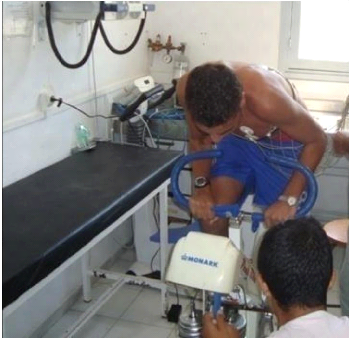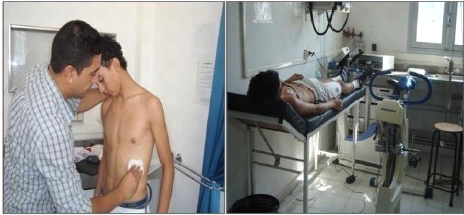II.1. The Wingate test
The Wingate test was performed on a Monark model 894E (Monark
AB, Varberg, Sweden) with pedals fitted with footrests. The athlete performs
maximum effort for 30 seconds against a braking force. For each subject the
load is determined according to body weight according to the Bar-Or
(1987) optimization table (87g / kg of body weight). During the test,
subjects were strongly encouraged to motivate them. The test then allows us to
record average power and peak power during exercise.

Photo 1: Achievement of the Wingate test II.2
Recording of heart variability
The work begins with a period of stabilization of the
autonomous system. The subject being completely isolated from his comrades, he
is asked to lie down for ten minutes while being awake (he is asked about not
falling asleep, not to talk, and not to change too much their breathing)
(Cassirame, 2007).
From this moment, the protocol starts, which consists of
recording the heart rate with a Polar S810 watch (in RR mode):
1.
32
Recumbent position: in the supine position for ten minutes
without the subject making any movement,
2. Standing position: Follows a second period of ten minutes
during which the subject moves to the standing position,
3. During the effort: during the third period, the subject is
asked to pass on the cyclo-ergometer where he will pedal for 2'30 " at moderate
intensity as a warm-up, then the subject will execute the Wingate test (30 sec
of maximum effort) then continue pedalling for 2 min at empty load as active
recovery.

Photo 2 and 3: Recording heart variability at
rest
The environment is kept stable, with an average temperature
and atmospheric pressure of (25 #177; 1° C, 45%), a decrease in noise and
no movement around the person. The data was then analyzed using KUBIOS HRV 2.0
software for the study of cardiac variability.
The KUBIOS HRV 2.0. is a software that allows to study the
activity of the sympathovagal balance. Indeed, through this software, we can
analyze individually the sympathetic and parasympathetic effect on cardiac
function. Data obtained by POLAR S810 were transferred to KUBIOS, and analyzed
on time and frequency plans. This non-invasive method to study cardiac function
and its control by the vegetative nervous system has shown its credibility
which according to Gamelin et al. (2005), has achieved the
same results as a direct recording of the heart rate (ECG).
33
III. Statistical analysis
Statistical analysis of the data was performed using the
Statistica 6.01 software (Stat Soft, France). Values are expressed as mean
#177; standard deviation.
Data analysis was performed as follows:
· One-way analysis of variance (ANOVA) (Ramadan: BR, R2,
R4) for the Wingate test.
· One-way analysis of variance (ANOVA) (Ramadan: BR, R2,
R4) for cardiac variability parameters.
For each analysis, when the ANOVA shows a significant effect, a
Tukey post-hoc test is applied to compare the experimental data in pairs. All
observed differences are considered statistically significant for a probability
threshold of less than 0.05.
Part III : Results
I. 35
Anthropometric characteristics of the sample
Anthropometric parameters are shown in Table II. The analysis of
the variance did not show a significant effect for the weight and BMI
parameters that were not changed during the three measurement periods.
Table II: Mean #177; SD
anthropometric characteristics of the subjects during the second week, the
fourth week and before Ramadan (n = 9).
|
B R
|
R 1
|
R 2
|
|
|
|
|
Weight (KG)
|
65.78 #177; 5.71
|
65.55 #177; 5.56
|
64.74 #177; 6.11
|
|
|
|
|
|
|
|
|
BMI
|
21,23 #177; 1.73
|
21,16#177; 1.76
|
20.90 #177; 1.81
|
|
II. The Wingate test
The parameters calculated from the Wingate test during the second
week, the fourth week and before Ramadan are presented in Table 3.
Table III: Mean #177; SD of Wingate
test parameters during the second and fourth week of Ramadan and Before Ramadan
(n = 9).
|
B R
|
R1
|
R2
|
|
|
|
|
|
Ppic (W)
|
623,11#177;75,96
|
622,58#177;62,02
|
622,44#177;69,01
|
|
|
|
|
|
Ppic (W/kg)
|
9,51#177;0,58
|
9,48#177;0,63
|
9,62#177;0,59
|
|
|
|
|
|
Pave (W)
|
495,43#177;49,6
|
494,75#177;64,3
|
492,45#177;71,91
|
|
|
|
|
|
Pave (W/kg)
|
7,57#177;0,62
|
7,55#177;0,66
|
7,61#177;0,36
|
| 


